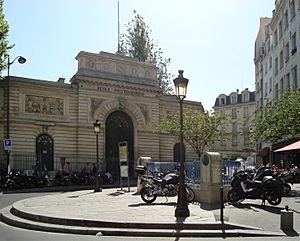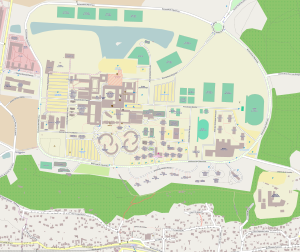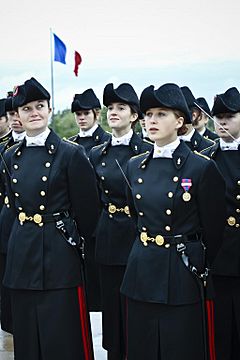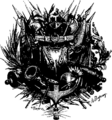École polytechnique facts for kids
 |
|
|
Other name
|
l'X |
|---|---|
|
Former name
|
École centrale des Travaux publics (Central School of Public Works) |
| Motto | Pour la Patrie, les Sciences et la Gloire |
|
Motto in English
|
For the Homeland, Science, and Glory |
| Type | Grande école |
| Established | 1794 |
|
Parent institution
|
Polytechnic Institute of Paris |
|
Academic affiliations
|
CGE, CDEFI |
| President | Laura Chaubard (by interim) |
| Director | Laura Chaubard |
| Students | 3,370 |
| Undergraduates | 480 |
| Postgraduates | 2,000 engineer candidates 500 masters |
| 390 | |
| Location |
Palaiseau
,
France
48°42′45″N 2°12′36″E / 48.7125°N 2.2100°E |
| Colors | Red & yellow |
| Battalion of École polytechnique | |
|---|---|
| Bataillon de l'École polytechnique | |
 |
|
| Founded | 28 September 1794 |
| Country | France |
| Allegiance | France |
| Type | Public research university |
| Part of | French Armed Forces |
| Motto(s) | Pour la Patrie, les Sciences et la Gloire |
| Wars | Sixth Coalition World War II |
| Battle honours | Legion of Honour
Croix de guerre 1914–1918 Croix de guerre 1939–1945 citation to the order of the army |
| Commanders | |
| Commanding Officer | General Armament Engineer Laura Chaubard |
| Colonel of the Regiment | Cyrille Caron head of corps and director of human and military training |
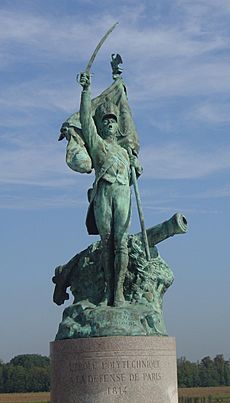
École polytechnique (which means "Polytechnic School") is a famous French grande école. It is also known as Polytechnique or l'X. This school is in Palaiseau, France. It focuses on science and engineering. It is also a founding member of the Polytechnic Institute of Paris.
The school was started in 1794 by a mathematician named Gaspard Monge. This was during the French Revolution. In 1804, Napoleon I made it a military school. Today, the French Ministry of Armed Forces still oversees it. The school used to be in central Paris. It moved to Palaiseau in 1976. This new location is part of the Paris-Saclay technology area.
Students studying engineering at Polytechnique get military training first. They are paid like officer cadets. The school also offers doctoral degrees since 1985. Master's degrees have been available since 2005, and bachelor's degrees since 2017. Many graduates become top leaders in companies. They also become senior government officials, military officers, or researchers.
Many famous people have graduated from Polytechnique. These include three Nobel Prize winners and a Fields Medalist. Three presidents of France also studied here. Many CEOs of French and international companies are alumni. Famous mathematicians like Augustin-Louis Cauchy and Henri Poincaré attended. Physicists like Henri Becquerel and André-Marie Ampère also graduated from here.
Contents
What's in a Name?
The school started in 1794. It was first called the École centrale des travaux publics. This means "Central School of Public Works." It taught only technical skills at first. In 1795, the school changed its name to "École polytechnique." The word "polytechnique" means "many arts." This shows that the school taught many subjects. These included applied arts, sciences, technology, and engineering.
Over the years, the school's official name changed. It was called "École royale polytechnique" under kings. It became "École impériale polytechnique" under emperors. Students and graduates are called "Polytechnicians." People often just call the school "Polytechnique."
Why "l'X"?
The school has been nicknamed "l'X" or "the X" since the mid-1800s. There are two main ideas about why. One idea is that it comes from the two crossed cannons on the school's badge. The other idea is that it's because mathematics is very important in the school's training. In math, "x" is often used for unknown values.
The nickname "X" also applies to the students. Female Polytechnicians are sometimes called "Xettes."
School History
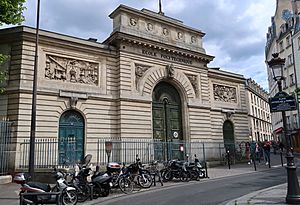
How the School Started
After the French Revolution in 1789, royal engineering schools closed. France needed more engineers and military officers. So, on September 28, 1794, the "Central School of Public Works" was created. It opened to students on December 21, 1794. The goal was to train engineers for both civilian and military jobs. The school quickly had 400 students.
A year later, the school was renamed "École polytechnique." This new name showed its wider purpose. It now prepared students for other specialized schools. The course lasted three years. About 120 new students joined each year.
In 1805, Emperor Napoleon I moved the school to central Paris. He made it a military academy. He also gave it its motto: Pour la Patrie, les Sciences et la Gloire (For the Nation, Science, and Glory). The school became more focused on military training and mathematics.
Students in Wars
In 1814, students helped defend Paris against the Sixth Coalition. During World War I, students were called to serve in the military. The school building became a hospital. More than 800 students died in the war. In 1921, foreign students could take the entrance exam for the first time.
During World War II, the school moved to Lyon. It lost its military status for a while. Its Paris buildings were used by the Red Cross. More than 400 students died during this war.
From Post-War to Today
In 1944, the school was again under the Ministry of War. In 1970, it became a civilian school. It was still overseen by the Ministry of Defence. The first female students were allowed in 1972. One woman, Anne Chopinet, was the top student in her class.
In 1976, the school moved from Paris to Palaiseau. This is a suburb south of Paris. In 1985, it started offering doctoral degrees. In 1994, the school celebrated its 200th birthday. In 1995, a new entrance exam was created for international students. In 2000, the main engineering program became four years long.
School Locations
Early Homes
In 1794, École polytechnique was first in the Palais Bourbon. A year later, it moved to the Hôtel de Lassay. This was a private mansion in Paris.
Paris Campus (1805–1976)
In 1805, Napoleon moved the school to the Quartier Latin in central Paris. It was near the Panthéon. Students nicknamed this Paris campus "Carva."
Palaiseau Campus (Since 1976)
The current campus is in Palaiseau, about 14 kilometers (9 miles) from central Paris. It has teaching buildings, student housing, and dining services. There are also many sports facilities for the 4,600 people who live there.
The closest train station is Lozère. Buses also connect the school to other train stations. The campus is near other science places. These include the Commissariat à l'énergie atomique et aux énergies alternatives and Université Paris-Sud.
How the School Works
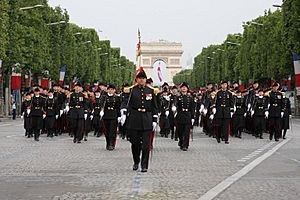
École polytechnique is a higher education school. It is overseen by the French Ministry of Defence. It trains both civilian engineers and scientists. It also trains officers for the French military. The goal is to provide France with top scientists and technical experts.
The school is led by a general officer. It also has military staff for leadership and training. French students in the main program are cadets. They must go through military training before they start their studies.
Students do not wear uniforms on campus every day. But for special events, they wear a 19th-century-style uniform. This includes a special hat called a bicorne. They wear this for military parades, ceremonies, and other important events.
Teachers and Research
École polytechnique has a general engineering program. It also has a doctoral school. Many researchers and professors from other places teach here. These include national science groups like CNRS. This creates a high-level learning environment.
Teachers at Polytechnique are usually contract employees. They are not civil servants like in public universities. Some are full-time and do research. Others are part-time and often come from research organizations.
Study Programs
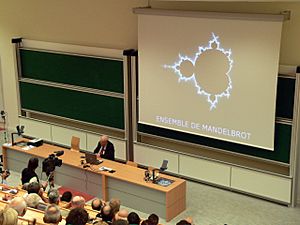
The Ingénieur polytechnicien Program
This program awards a special engineering degree. It is very hard to get into. The courses cover many subjects. This helps students learn across different fields. About 2,000 students are in this program. The school also has about 439 master's students and 572 doctoral students.
How to Get In
There are two main ways to join this program. The first is through a very tough exam. This usually needs two years of intense study after high school. The second way is for students who have done undergraduate studies at another university. There are written exams in spring and oral exams in summer.
About 400 French students are accepted each year. Around 100 foreign students also get in through the same exam. Foreign students from other universities can also come for an exchange program.
What You Study
The engineering degree takes four years.
- First year
French students start with eight months of military service. This is called "human and military training." They spend a month at a military training center. Then they are assigned to civilian service or to the Army, Navy, Air Force, or Gendarmerie. They spend five months working in a military unit.
After this, all students take five main courses for four months. These are Mathematics, Applied Mathematics, Physics, Computer Science, and Economics.
- Second year
This year is about studying many different subjects. Students choose 12 courses from at least five different areas. These include science fields like biology and chemistry. They also include humanities like foreign languages.
- Third year
In the third year, students choose a special area to focus on. This is often one subject or a mix of subjects. This year ends with a research internship. Students also earn a Master's degree in engineering, science, and technology.
- Fourth year
The fourth year is for more specialized studies. Students either go into a Master's or doctoral program. Or they join a partner school or institute. This is because the general education at Polytechnique helps students think. But they need more technical training for a real engineering job.
After Graduation
The grades from the second year help rank French students. This ranking is important for joining government jobs. Many top government jobs are open only to Polytechnique students. Graduates can join special government groups. They then go to technical schools for civil service.
About 47% of graduates work in the private sector. Most of them (58%) work in the Paris area. About 34% work outside France. Graduates earn about €44,000 per year on average.
Costs and Pay
French students at École polytechnique do not pay tuition fees. They also get a salary as officer cadets. They share some of this money with foreign students. There are no special financial rules for students who finish the program.
Bachelor Program
The Bachelor program started in 2017. It is a three-year program taught completely in English. Both French and international students can apply. High school students in their final year can apply. Students are chosen based on their application and an interview. In the first year, students study many math-based subjects.
Master's Program
École polytechnique offers many master's programs. These are often with other schools and universities. They cover many specialized subjects. These include AI, computer vision, economics, and environmental science. Some business degrees are with HEC Paris.
Doctoral Program
The school also has a doctoral program. Students with a master's degree can join. Doctoral students usually work in the school's labs. They can also work in other research places. About 40% of doctoral students are from other countries.
Research Labs
École polytechnique has many research laboratories. They work in different science fields. These include physics, mathematics, computer science, and biology. Most labs work with national science groups like CNRS.
Student Life
Students have a board of 16 students called "la Kès." They are elected every November. La Kès helps with relationships between students, teachers, and school leaders. They also publish a weekly student newspaper called InfoKès.
Sports
Sports are a big part of student life. All students must play 6 hours of sports each week. There are many sports clubs. These include skydiving, judo, and hiking. The campus has two swimming pools, dojo rooms, and an equestrian center. The "Jumping de l'X" is an international horse jumping competition the school organizes.
Famous People
Many graduates of École polytechnique become important people. They work in government, industry, and research in France. Its alumni include three Nobel Prize winners. Three French presidents also graduated from here. Many business leaders are also alumni. Researchers have found that many top business leaders in France studied at École polytechnique.
Rankings
General Rankings
In global rankings, École polytechnique is ranked as part of the Polytechnic Institute of Paris.
Research Performance
In 2020, the Performance Ranking of Scientific Papers for World Universities ranked the university 475th globally. Its "Engineering Subjects" were ranked 451–500th in the world. In 2020, it was ranked 509th in the world by the University Ranking by Academic Performance.
Other Rankings
In 2015, Times Higher Education ranked École polytechnique third among small universities. It was behind Caltech and École normale supérieure (Paris).
| Year | QS Rank (Change) |
|---|---|
| 2014 | 41 |
| 2015 | 35 ( |
| 2016 | 40 ( |
| 2017 | 53 ( |
| 2018 | 59 ( |
| 2019 | 65 ( |
| 2020 | 60 ( |
| 2021 | 61 ( |
The Mines ParisTech: Professional Ranking World Universities looks at where Fortune 500 CEOs went to school. In 2011, it ranked École polytechnique seventh in the world. It was second among French schools, after HEC Paris.
| Year | Rank (Change) |
|---|---|
| 2007 | 4 ( |
| 2008 | 15 ( |
| 2009 | 14 ( |
| 2010 | 12 ( |
| 2011 | 7 ( |
Criticisms
Some people criticize French grandes écoles, including École polytechnique. They say these schools are too "elitist" and lack diversity. Studies have shown that children from wealthier families are more likely to get into these schools. A recent report found that children of employers are 50 times more likely to enter École polytechnique than children of workers.
Gallery
-
Polytechnique cadets at the Bastille Day Military Parade
-
The Polytechnique bicorne hat
See also
 In Spanish: École polytechnique para niños
In Spanish: École polytechnique para niños
- Traditions of the École Polytechnique
- Grandes écoles
- Higher education in France
- Centre de mathématiques Laurent-Schwartz
- LULI




